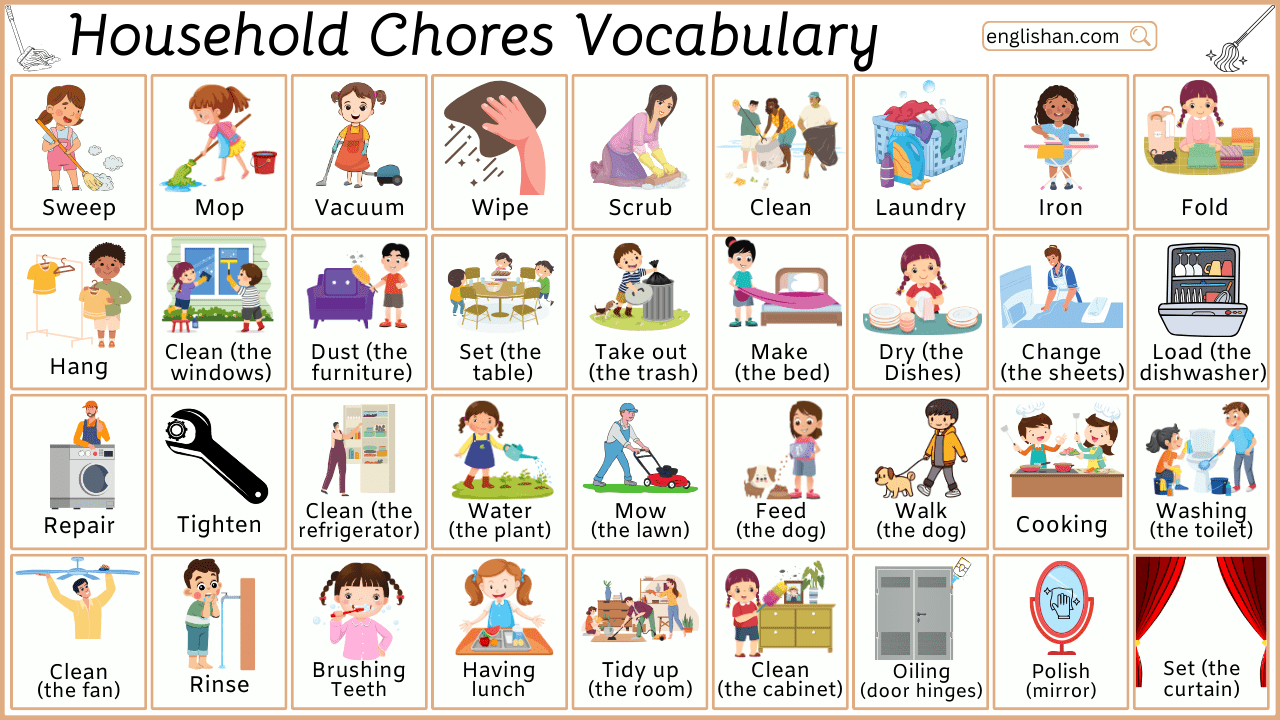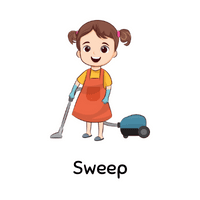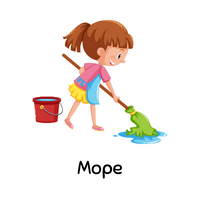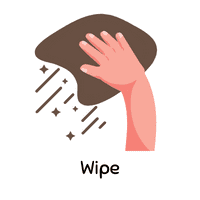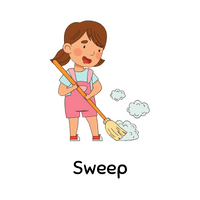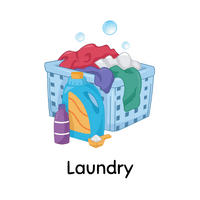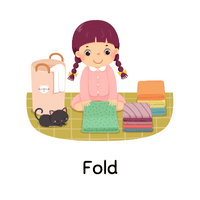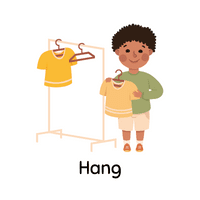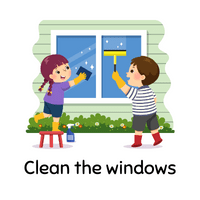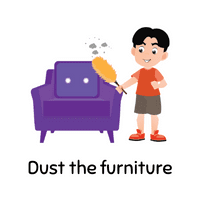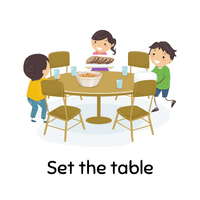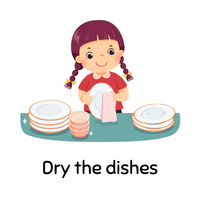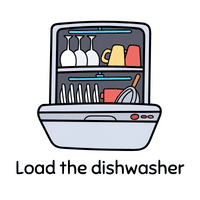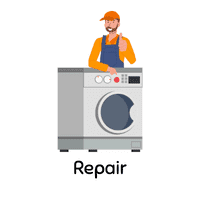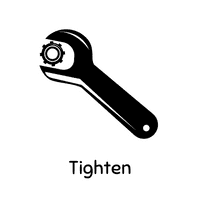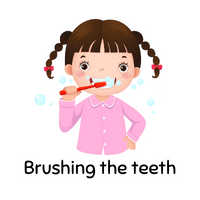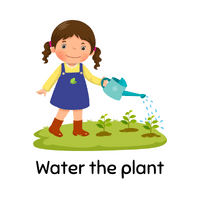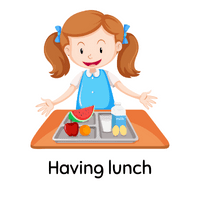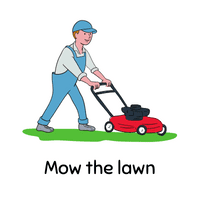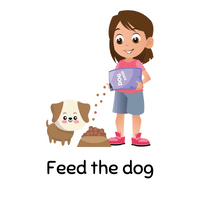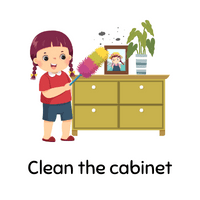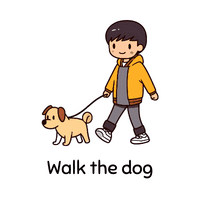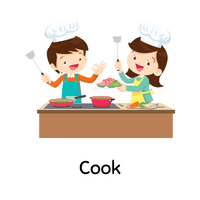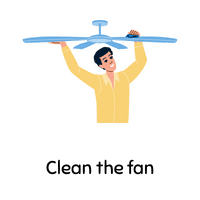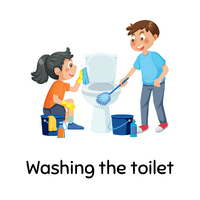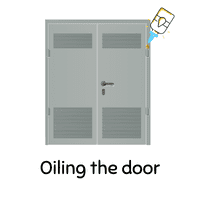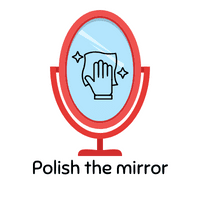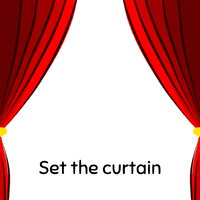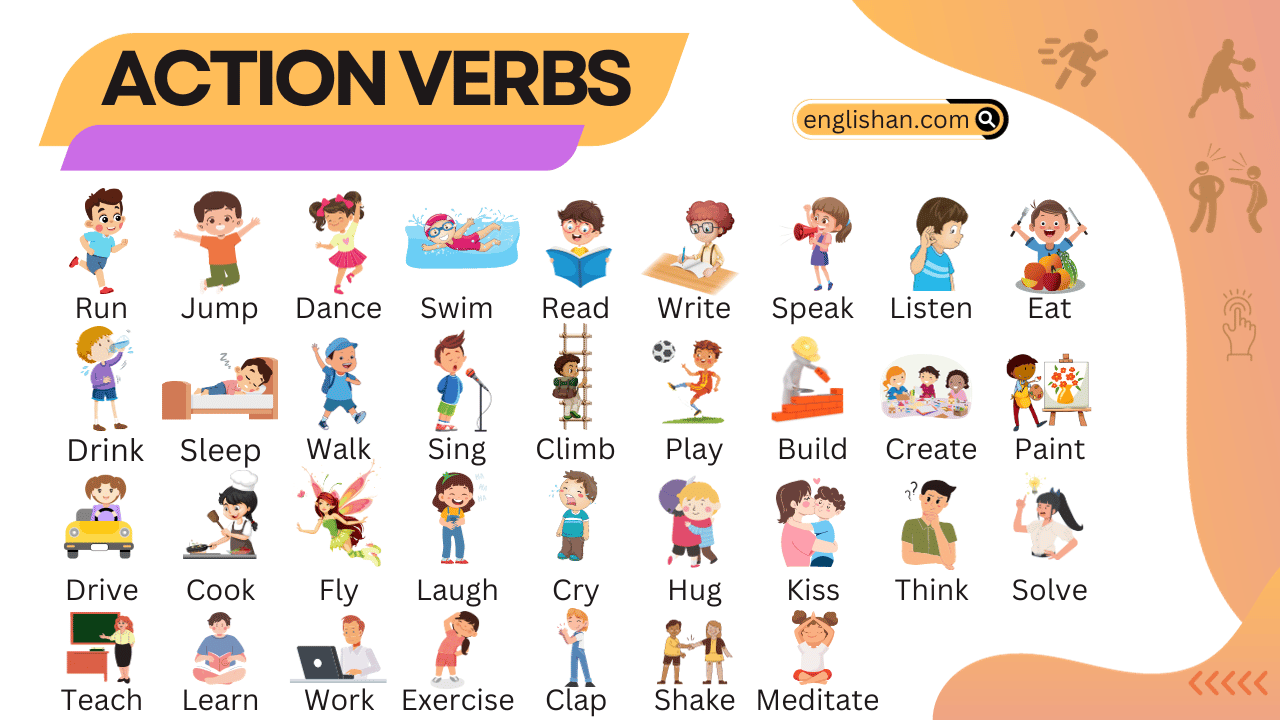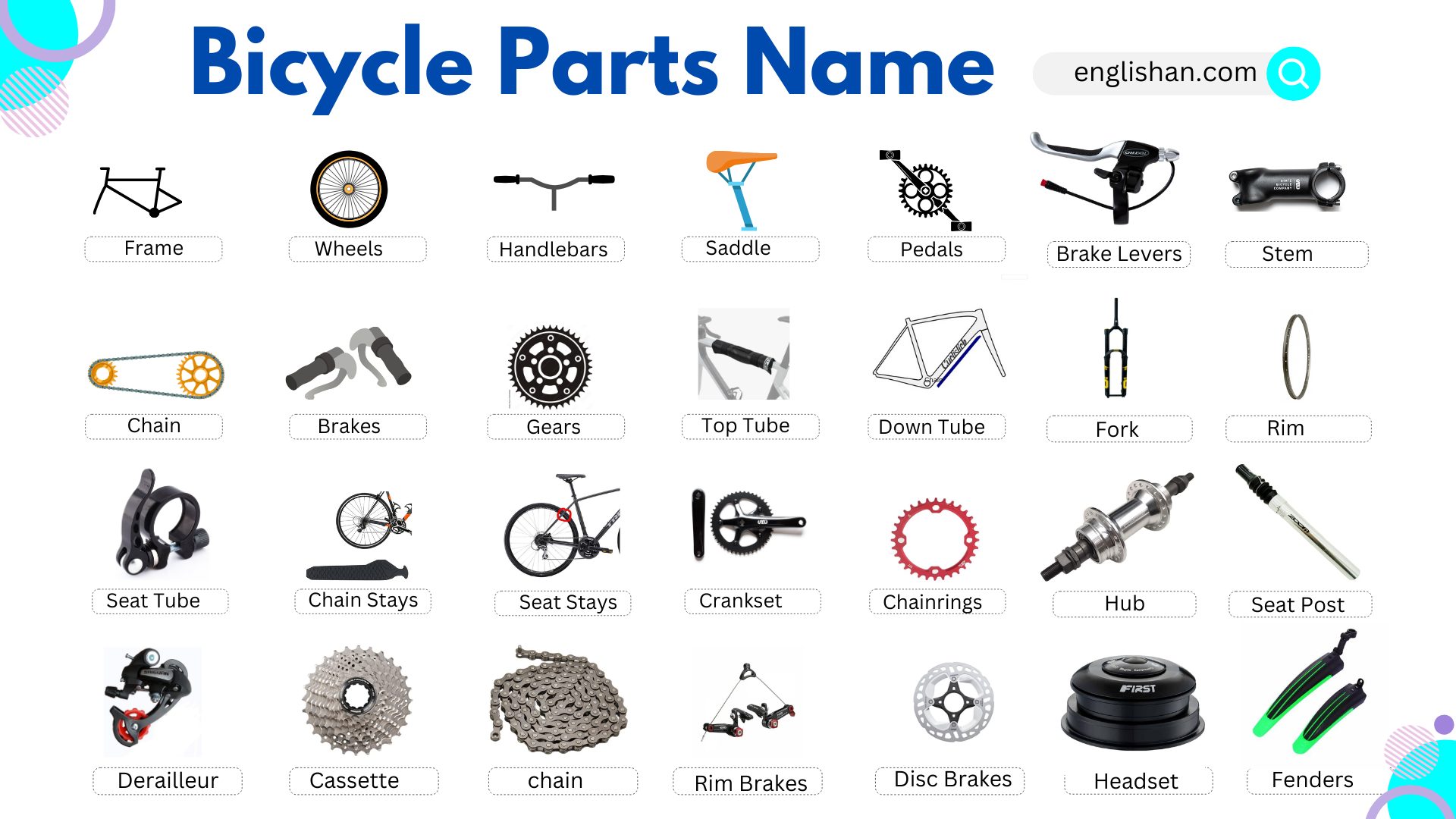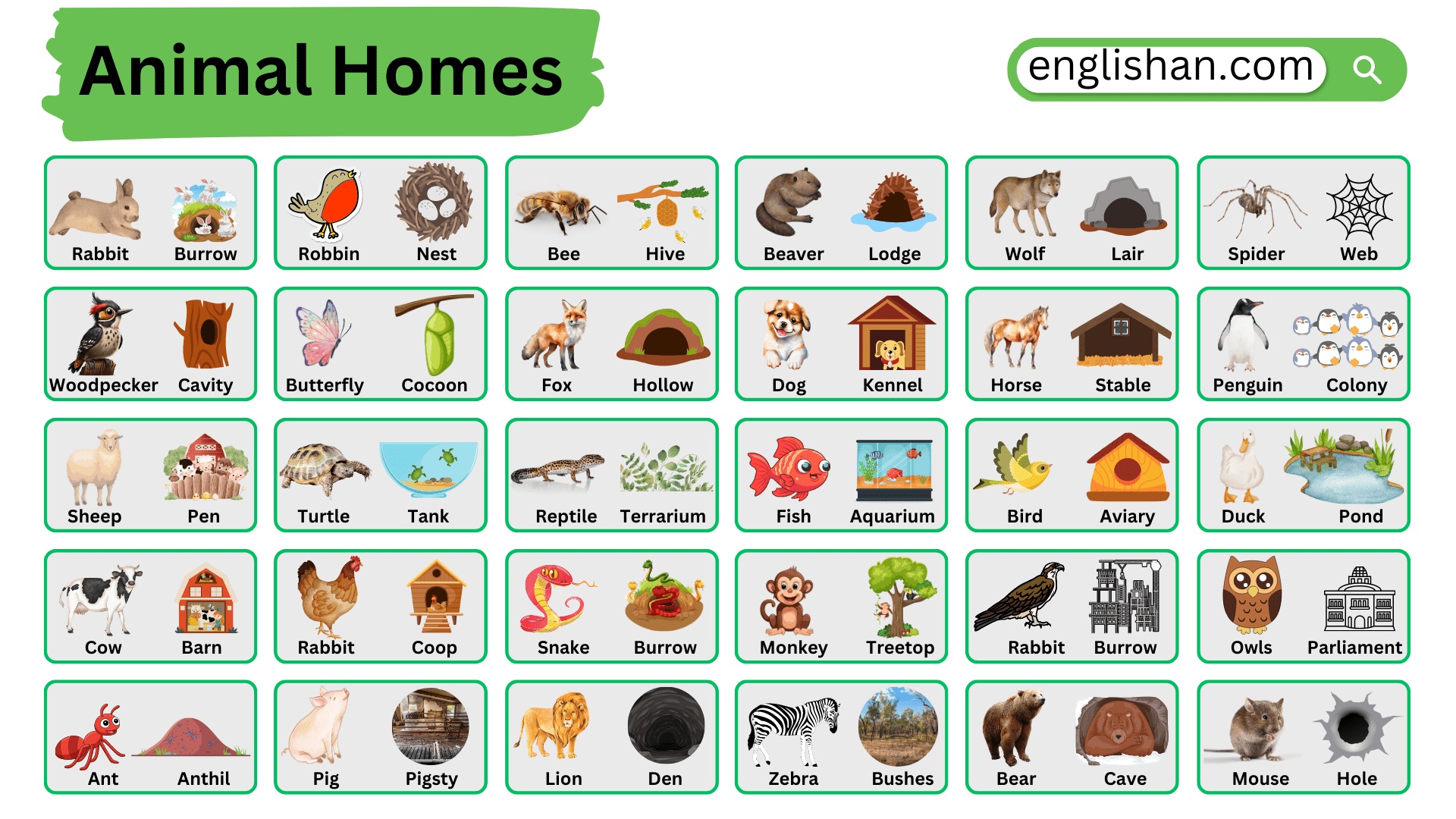Contents
In this blog post, you will learn common vocabulary for household chores with translations from Urdu to English. Understanding these words can help you describe daily tasks and improve your communication skills. Whether you’re a student or a language learner, this vocabulary list will make it easier to talk about household activities in English. To learn more vocabulary on different topics, visit our Vocabulary Category.
List of Household Chores Vocabulary
Learn More About Household Chores Vocabulary
Sweep
Using a broom to gather dirt, dust, and small debris into a pile so it can be disposed of easily. Sweeping is done on hard floors like wood, tile, or linoleum to keep them clean and tidy.
Mop
After sweeping, mopping involves using a wet mop or cloth to clean the floor thoroughly. This helps remove any remaining dirt, spills, or stains, leaving the floor shiny and hygienic.
Vacuum
Vacuuming is the process of using a vacuum cleaner to remove dirt, dust, and other debris from carpets, rugs, and upholstery. It’s an effective way to keep soft surfaces clean and allergens-free.
Wipe
Wiping involves using a damp cloth or paper towel to clean surfaces like countertops, tables, and appliances. It helps remove dust, spills, and stains, leaving surfaces clean and sanitized.
Scrub
Scrubbing is a more intensive cleaning method that involves using a brush or sponge along with cleaning products to remove tough stains, grime, or buildup from surfaces like sinks, tubs, and tiles.
Clean
Cleaning is a general term that encompasses all household chores aimed at maintaining cleanliness and orderliness in the living environment. It includes tasks like sweeping, mopping, wiping, and scrubbing various surfaces.
Laundry
Laundry refers to the process of washing, drying, and folding clothes, linens, and other fabric items. It involves sorting clothes, using laundry detergent, and following specific washing instructions to ensure clean and fresh-smelling laundry.
Iron
Ironing is the process of using a heated iron to remove wrinkles and creases from clothes and fabric items. It helps give clothes a neat and polished appearance.
Fold
Folding is the act of neatly arranging clothes and linens into manageable sizes for storage in drawers, closets, or shelves. It helps save space and keeps clothes organized.
Hang
Hanging involves suspending clothes or linens on hangers or hooks to air dry or store them neatly in closets. It prevents wrinkles and maintains the shape of clothing items.
Clean (the windows)
Cleaning windows involves removing dirt, dust, and streaks from glass surfaces using a cleaning solution and a squeegee or cloth. It helps improve visibility and lets more natural light into the home.
Dust (the furniture)
Dusting is the process of removing dust and cobwebs from furniture surfaces using a dry cloth or a duster. It helps maintain the appearance of furniture and reduces allergens in the home.
Set (the table)
Setting the table involves arranging dishes, utensils, and glassware in a specific manner before a meal. It creates an inviting dining atmosphere and prepares the table for serving food.
Take out (the trash)
Taking out the trash involves removing garbage bags or bins filled with waste from inside the house to an outdoor trash receptacle for disposal. It helps keep the home clean and free of odors.
Make (the bed)
Making the bed involves arranging sheets, blankets, and pillows neatly to create a tidy and inviting sleeping area. It helps start the day off on an organized note and promotes better sleep hygiene.
Dry (the dishes)
Drying dishes is the process of removing moisture from washed dishes, glasses, and utensils using a dish towel or dish rack. It helps prevent water spots and ensures dishes are ready for use or storage.
Change (the sheets)
Changing sheets involves removing dirty or soiled bed linens and replacing them with fresh, clean ones. It helps maintain hygiene and comfort in the bedroom.
Load (the dishwasher)
Loading the dishwasher involves arranging dirty dishes, glasses, and utensils in the dishwasher’s racks in a way that maximizes cleaning efficiency. It helps streamline the dishwashing process and saves time.
Repair
Repairing involves fixing or restoring household items, appliances, or fixtures that are damaged, broken, or malfunctioning. It helps prolong the lifespan of belongings and ensures they function properly.
Tighten
Tightening involves securely fastening loose screws, bolts, or fittings on furniture, fixtures, or appliances using appropriate tools. It helps prevent further damage and ensures stability and safety.
Clean (the refrigerator)
Cleaning the refrigerator involves removing expired or spoiled food, wiping down shelves and drawers, and sanitizing surfaces to maintain food safety and freshness.
Rinse
Rinsing involves using water to remove soap, detergent, or cleaning products from surfaces after cleaning. It helps prevent residue buildup and ensures surfaces are clean and residue-free.
Brushing Teeth
Brushing teeth is the act of cleaning teeth and gums using a toothbrush and toothpaste to remove plaque, bacteria, and food particles. It helps maintain oral hygiene and prevent dental problems like cavities and gum disease.
Water (the plant)
Watering plants involves supplying them with the appropriate amount of water to keep them hydrated and healthy. It helps promote growth and maintains the appearance of indoor and outdoor plants.
Having lunch
Having lunch refers to the act of eating a midday meal. It typically involves consuming food and beverages to satisfy hunger and provide nourishment during the day.
Mow (the lawn)
Mowing the lawn involves using a lawnmower to trim grass to a uniform height, enhancing the appearance of the lawn and promoting healthy growth.
Feed (the dog)
Feeding the dog involves providing food and water to a pet dog to meet its nutritional needs and ensure its well-being.
Clean (the cabinet)
Cleaning cabinets involves removing items, wiping down surfaces, and organizing contents to keep cabinets clean, dust-free, and organized.
Tidy up (the room)
Tidying up a room involves straightening, organizing, and removing clutter to create a neat and orderly living space.
Walk (the dog)
Walking the dog involves taking a pet dog for a stroll outdoors to provide exercise, mental stimulation, and opportunities for bathroom breaks.
Cooking
Cooking involves preparing food by combining ingredients and using heat to transform them into meals or dishes for consumption.
Clean (the fan)
Cleaning a fan involves removing dust and debris from fan blades and housing to ensure optimal airflow and prevent the spread of allergens.
Washing (the toilet)
Washing the toilet involves using a toilet brush and cleaning solution to scrub and sanitize the toilet bowl, seat, and exterior surfaces.
Oiling (door hinges)
Oiling door hinges involves applying lubricant or oil to hinges to reduce friction, prevent squeaking, and ensure smooth operation.
Polish (Mirror)
Polishing a mirror involves using a cleaning solution and cloth to remove smudges, streaks, and dust, leaving the mirror clean and shiny.
Set (the curtain)
Setting curtains involves hanging or arranging curtain panels or drapes to cover windows or doorways for privacy, light control, or decoration.














FAQs
1. What is household chores dictionary?
Here’s a short list of household chores:
Sweep: Clean with a broom.
Mop: Wash the floor.
Vacuum: Clean with a machine.
Dust: Wipe off dirt.
Wash Dishes: Clean plates.
Do Laundry: Wash clothes.
Iron: Smooth clothes.
Cook: Make food.
Take Out Trash: Throw away garbage.
Make the Bed: Tidy up the bed.
Fold Clothes: Neatly fold clothes.
Clean Windows: Wash windows.
Water Plants: Give plants water.
Take Care of Pets: Feed pets.
Let me know if you’d like anything else!
Here’s a short way to talk about household chores:
Task: “I need to sweep the floor.”
Ask for Help: “Can you wash the dishes?”
What You Did: “I vacuumed the floor.”
Routine: “I do the laundry on weekends.”
This keeps it simple and easy!
To start chores for kids:
Pick Simple Tasks
Set a Routine
Explain Clearly
Use a Chore Chart
Praise Them
Keep it Short
This makes chores fun and manageable for kids!
Download Household Chores Vocabulary PDF Here ⬇

You May Also Like
